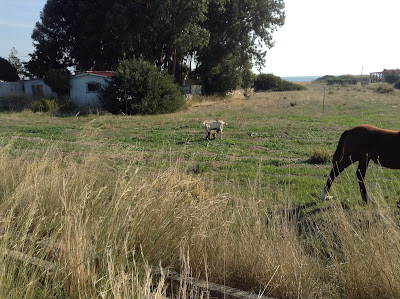Trawling through the photo archive of late, I began to see just how many photos of wildlife (not all of them very good, admittedly) I've now got accumulating on the HD. So, I thought I'd shove just a few of them in a post, along with a brief caption to accompany them.
Here goes then (Usual reminder: Don't forget you can view the photos larger by clicking on them)...
So, there you are folks. My attempt at a little nature-watch. I was hoping to meet Kate Humble, but she hasn't put in an appearance. Drat.
Here goes then (Usual reminder: Don't forget you can view the photos larger by clicking on them)...
 |
| There she is again, can you see her on the truncated palm frond? |
 |
| Ditto |
 |
| OK, so not actually wildlife, but this little baby goat was only hours old when we walked past last February. Mum was keeping a beady protective eye as we passed. |
 |
| Ditto. |
 |
| And, finally. Full marks to the staff at the Rodos Princess Hotel, just along the road from our place. We always take a cheeky shortcut through the hotel when walking home from a dip at the beach. This swallows' nest is situated half-way up a stairwell, on the wall of the corner landing, and the staff I'm glad to say didn't knock it off, but let the parents build it and, as I type this, rear two broods so far this summer. Anyone who's had swallows nesting on their property will know the mess that can accumulate on the floor beneath the nest. The staff at the hotel have been diligently cleaning that up and keeping the area spick and span, whilst mercifully allowing these most beautiful of visitors to do what comes naturally. The parents have to fly out from the stairwell and along a short section of corridor before they reach the open air, so they regularly fly very close to the human guests at the hotel. |
So, there you are folks. My attempt at a little nature-watch. I was hoping to meet Kate Humble, but she hasn't put in an appearance. Drat.








Lovely glimpses of the non-human life with which you share your home and surrounding areas, John. I thought myself very lucky in April to catch sight of a golden oriole above Fokia bay in Pefkos. By the time I had picked my jaw up from the ground I was too late to use either camera or phone to grab a photo.
ReplyDeleteVicki
Far be it from me to doubt you Vicki, but we do get Hoopoes here, but as yet I have never seen an oriole, although I did see them in Southern France some years ago. I'll private message you a couple of photos. If you're sure it was a Golden Oriole then it's very exciting. The Hoopoe can be confused with an oriole, although not if one sees them together of course. The oriole's yellow is much more vivid.
ReplyDelete